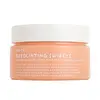What's inside
What's inside
 Key Ingredients
Key Ingredients

 Benefits
Benefits

 Concerns
Concerns

 Ingredients Side-by-side
Ingredients Side-by-side

Water
Skin ConditioningKaolin
AbrasivePropanediol
SolventOlea Europaea Fruit Oil
MaskingGlycerin
HumectantCetearyl Alcohol
EmollientLuffa Cylindrica Fruit
AbrasiveButyrospermum Parkii Butter
Skin ConditioningGlyceryl Stearate
EmollientPEG-100 Stearate
Phenoxyethanol
PreservativeParfum
MaskingCaprylyl Glycol
EmollientPolysorbate 60
EmulsifyingSodium Polyacrylate
AbsorbentPrunus Armeniaca Seed Powder
AbrasiveAcrylates/C10-30 Alkyl Acrylate Crosspolymer
Emulsion StabilisingAloe Barbadensis Leaf Juice Powder
Skin ConditioningTocopherol
AntioxidantTrisodium Ethylenediamine Disuccinate
Butyl Methoxydibenzoylmethane
UV AbsorberTaraxacum Officinale Rhizome/Root Extract
Skin ConditioningMenthol
MaskingSodium Hydroxide
BufferingTetrasodium Pyrophosphate
BufferingLimonene
PerfumingCitric Acid
BufferingCamellia Sinensis Leaf Extract
AntimicrobialEthylhexylglycerin
Skin ConditioningSodium Benzoate
MaskingPotassium Sorbate
PreservativeCaramel
Cosmetic ColorantCI 19140
Cosmetic ColorantCI 42090
Cosmetic ColorantWater, Kaolin, Propanediol, Olea Europaea Fruit Oil, Glycerin, Cetearyl Alcohol, Luffa Cylindrica Fruit, Butyrospermum Parkii Butter, Glyceryl Stearate, PEG-100 Stearate, Phenoxyethanol, Parfum, Caprylyl Glycol, Polysorbate 60, Sodium Polyacrylate, Prunus Armeniaca Seed Powder, Acrylates/C10-30 Alkyl Acrylate Crosspolymer, Aloe Barbadensis Leaf Juice Powder, Tocopherol, Trisodium Ethylenediamine Disuccinate, Butyl Methoxydibenzoylmethane, Taraxacum Officinale Rhizome/Root Extract, Menthol, Sodium Hydroxide, Tetrasodium Pyrophosphate, Limonene, Citric Acid, Camellia Sinensis Leaf Extract, Ethylhexylglycerin, Sodium Benzoate, Potassium Sorbate, Caramel, CI 19140, CI 42090
Ingredients Explained
These ingredients are found in both products.
Ingredients higher up in an ingredient list are typically present in a larger amount.
Parfum is a catch-all term for an ingredient or more that is used to give a scent to products.
Also called "fragrance", this ingredient can be a blend of hundreds of chemicals or plant oils. This means every product with "fragrance" or "parfum" in the ingredients list is a different mixture.
For instance, Habanolide is a proprietary trade name for a specific aroma chemical. When used as a fragrance ingredient in cosmetics, most aroma chemicals fall under the broad labeling category of “FRAGRANCE” or “PARFUM” according to EU and US regulations.
The term 'parfum' or 'fragrance' is not regulated in many countries. In many cases, it is up to the brand to define this term.
For instance, many brands choose to label themselves as "fragrance-free" because they are not using synthetic fragrances. However, their products may still contain ingredients such as essential oils that are considered a fragrance by INCI standards.
One example is Calendula flower extract. Calendula is an essential oil that still imparts a scent or 'fragrance'.
Depending on the blend, the ingredients in the mixture can cause allergies and sensitivities on the skin. Some ingredients that are known EU allergens include linalool and citronellol.
Parfum can also be used to mask or cover an unpleasant scent.
The bottom line is: not all fragrances/parfum/ingredients are created equally. If you are worried about fragrances, we recommend taking a closer look at an ingredient. And of course, we always recommend speaking with a professional.
Learn more about ParfumPotassium Sorbate is a preservative used to prevent yeast and mold in products. It is commonly found in both cosmetic and food products.
This ingredient comes from potassium salt derived from sorbic acid. Sorbic acid is a natural antibiotic and effective against fungus.
Both potassium sorbate and sorbic acid can be found in baked goods, cheeses, dried meats, dried fruit, ice cream, pickles, wine, yogurt, and more.
You'll often find this ingredient used with other preservatives.
Learn more about Potassium SorbatePropanediol is an all-star ingredient. It softens, hydrates, and smooths the skin.
It’s often used to:
Propanediol is not likely to cause sensitivity and considered safe to use. It is derived from corn or petroleum with a clear color and no scent.
Learn more about PropanediolWater. It's the most common cosmetic ingredient of all. You'll usually see it at the top of ingredient lists, meaning that it makes up the largest part of the product.
So why is it so popular? Water most often acts as a solvent - this means that it helps dissolve other ingredients into the formulation.
You'll also recognize water as that liquid we all need to stay alive. If you see this, drink a glass of water. Stay hydrated!
Learn more about Water